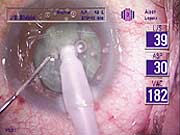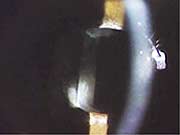Soft-shell technique effective, especially with poor endothelium
The technique’s results may be enhanced by using phaco chop and limiting the amount of viscoelastic material, a surgeon says.
TOKYO — Cataract surgeons should not shy away from using the soft-shell technique, according to a surgeon here.
“This technique can be highly effective, especially in patients with poor endothelium. But I have achieved even better results by limiting the amount of viscoelastic material and using phaco chop,” said Hiroko Bissen-Miyajima, MD, PhD, director and associate professor of ophthalmology at Tokyo Dental College Suidobashi Hospital.
The soft-shell technique was pioneered by Steve A. Arshinoff, MD.
“The original idea was to use two different viscoelastic materials. A cohesive viscoelastic material can maintain the space nicely, but easily comes out from the eye like spaghetti,” Dr. Bissen-Miyajima said.
Case Report: patient with an acute angle-closure | ||
One of Dr. Bissen-Miyajima’s cases involved an 84-year-old woman who had an acute angle-closure attack. Endothelial cell density decreased to 680 cells/mm2 and the woman had a dense nucleus. “In such cases, many patients develop bullous keratopathy following cataract surgery, and penetrating keratoplasty is indicated. The protection rendered by the soft-shell technique is very effective,” she said. Another benefit is that the technique can be repeated if there is any doubt about remaining Viscoat. In this particular case, Dr. Bissen-Miyajima added Viscoat before removing the last lens fragment, which had stayed close to the endothelium. | ||
|
|
|
A dispersive agent remains inside the eye during surgery to protect the corneal endothelium from direct contact with nuclear fragments, she added.
Dr. Bissen-Miyajima found that, as with any dispersive viscoelastic product, it is important to ensure that an adequate working space is created before initiating phaco. Moving to full phaco before creating this space can lead to a blocked phaco tip and restricted flow, which can cause heat buildup and the potential for corneal damage.
“If the anterior chamber is filled with Viscoat, the heat generated from the phaco tip increases and milky material will be recognized,” she said.
Also, she found that the unique retention and protective properties of Viscoat can occasionally provide some challenges.
“Nuclear fragments have a tendency to stick to Viscoat and hinder the surgeon from observing inside the eye,” she said.
Limiting Viscoat
To avoid these problems, the amount of Viscoat introduced into the anterior chamber is important.
“I usually inject only 0.1 to 0.2 mL. If there is too much Viscoat, the movement of lens material becomes very slow and it takes longer to aspirate at the end of surgery,” Dr. Bissen-Miyajima said.
The amount of cohesive viscoelastics following injection of Viscoat should also be considered.
“One should stop injecting when previously injected Viscoat spreads to the pupillary margin. If you continue injecting the cohesive agent, Viscoat will be pushed toward the angle,” she said.
For any phaco technique, it is necessary to control the lens fragments.
“The lens fragments should be kept under the ultrasonic tip, sometimes with the assistance of a second instrument,” she said.
Dr. Bissen-Miyajima’s surgical technique consists of a clear-corneal incision, followed by Viscoat and then ProVisc (1% sodium hyaluronate, Alcon) injected into the anterior chamber. A capsulorrhexis is made using a cystotome. Following hydrodissection, phaco chop is performed.
“Controlled handling of the nucleus is critical to minimize damage to the corneal endothelium,” she said.
Hard nucleus
The combination of soft-shell and phaco chop achieves better results, especially in eyes with a hard nucleus, Dr. Bissen-Miyajima said. She uses a flared micro ABS needle tip and ultrasound at 50% power.
“The thin layer of Viscoat acts like a cushion when nuclear fragments are about to touch the endothelium. You may notice that the air bubble stays under the endothelium during the procedure, which confirms the presence of Viscoat,” she said.
Through a 2.75-mm incision, a single-piece AcrySof (Alcon) is often injected, using the newly developed injector.
“Because the IOL comes out with a single push, I usually hold the eye with counterforce. The IOL is well-centered and the incision looks perfect,” she said.
Dr. Bissen-Miyajima’s results with the soft-shell technique are encouraging.
“Because there is minimal effect on corneal endothelium, patients have very clear corneas right after surgery and they achieve good vision. With better control of lens fragments, we rarely observe significant cell loss, even in cases with poor endothelium,” she said.
In a study of 280 eyes, refraction was stable by 30 minutes. Best corrected visual acuity was 20/30 on average, and improved to 20/20 at day 1.
Highly suitable cases
Although Dr. Bissen-Miyajima routinely employs the soft-shell technique, she finds it most suitable for cases with hard nucleus, poor endothelium due to corneal disease, previous surgery (such as intracapsular cataract extraction), a shallow anterior chamber and small pupil.
“Cataract surgery following penetrating keratoplasty has been critical. However, we have much better results now, so we do not hesitate to perform cataract removal, even in cases following keratoplasty,” she said.
Dr. Bissen-Miyajima shared results of five eyes (four cases) with poor endothelium (cell density less than 820 cells/mm2).
“Most of these cases were referred to us for cataract surgery with penetrating keratoplasty,” she said.
Because corneal clearness with slit-lamp examination was acceptable for phaco, cataract surgery was performed without keratoplasty. Preoperative endothelial cell density ranged as low as 431 cells/mm2.
“After 2 years of follow-up, none of these cases had developed bullous keratopathy, but specular microscopy is not easy and the results are not stable,” she said.
The cornea remained in its preoperative condition, and postop endothelial cell density stayed at 677, 667, 697, 849 and 674 cells/mm2. Moreover, postop BCVA was more than 20/25 in all five eyes, and three of the five eyes were 20/20 or better.
“The soft-shell technique certainly broadens the cataract indication for eyes with poor endothelium,” Dr. Bissen-Miyajima said.
For Your Information:
- Hiroko Bissen-Miyajima, MD, PhD, can be reached at Department of Ophthalmology, Tokyo Dental College, Suidobashi Hospital, 2-9-18 Misaki-cho, Chiyoda-ku, Tokyo 101-0061, Japan; (81) 3-3262-3421; fax: (81) 3-5275-1912; e-mail: hirokobm@aol.com. Dr. Bissen-Miyajima has no direct financial interest in the products mentioned in this article, nor is he a paid consultant for any companies mentioned.
- Alcon can be reached at 6201 South Freeway, Fort Worth, TX 76134; (817) 293-0450; fax: (817) 568-6142.



